AIR BEARING APPLICATION
AND DESIGN GUIDE
REVISION E -- JANUARY 2006
New Way Air Bearings 50 McDonald Blvd. Aston, PA 19014 USA 610.494.6700 www.newwayairbearings.com
�
New Way Air Bearings
Air Bearing Application and Design Guide
TABLE OF CONTENTS
PART I: UNDERSTANDING AIR BEARINGS .............................................................................3
1. Introduction ...........................................................................................................................................3
2. What is an air bearing?.......................................................................................................................3
3. Why use air bearings? ........................................................................................................................3
Friction ........................................................................................................................................3
Wear............................................................................................................................................3
Stiffness ......................................................................................................................................3
Load Capacity .............................................................................................................................3
4. Types of air bearing technology ........................................................................................................3
Aerodynamic bearings ................................................................................................................3
Aerostatic bearings .....................................................................................................................3
Orifice and Porous Media Technology........................................................................................3
5. Air Bearing Products ...........................................................................................................................3
Flat Bearings (Pucks)..................................................................................................................3
Air Bushings................................................................................................................................3
Vacuum Preloaded Bearings (VPLs)..........................................................................................3
Air Bearing Slides. ......................................................................................................................3
Radial Bearings...........................................................................................................................3
6. Air Bearing Applications......................................................................................................................3
Machines for the Image Setting Industry ....................................................................................3
Coordinate Measuring Machines ................................................................................................3
Testing Equipment......................................................................................................................3
High Speed Equipment...............................................................................................................3
Ultra accurate machine tools ......................................................................................................3
Linear Stages..............................................................................................................................3
OEM............................................................................................................................................3
Custom Projects and Test Rigs ..................................................................................................3
PART II: CHOOSING AIR BEARINGS ........................................................................................3
7. Selecting the right air bearing product for your application...........................................................3
© 2006, New Way Air Bearings
Air Bearing Application and Design Guide – Revision E
Page 2 of 68
�
Air Bearing Application and Design Guide
New Way Air Bearings
PART III: DESIGNING WITH AIR BEARINGS.............................................................................3
8. Air Bearing Guides ..............................................................................................................................3
Guide Surface Considerations....................................................................................................3
Surface finish ..............................................................................................................................3
Local flatness ..............................................................................................................................3
Holes in the guide .......................................................................................................................3
Seams in the guide way..............................................................................................................3
9. Stiffness and Preload..........................................................................................................................3
10. Loads Acting on Air Bearing Systems ..............................................................................................3
Gravity Loading...........................................................................................................................3
Payload distribution and mobility ................................................................................................3
Preloading with other air bearings ..............................................................................................3
Dynamic Loading ........................................................................................................................3
PART IV: SETTING UP AND USING AIR BEARINGS................................................................3
11. Flat Bearings ........................................................................................................................................3
Mounting and Adjusting ..............................................................................................................3
Adjusting Main bearings..............................................................................................................3
Adjusting Preload bearings.........................................................................................................3
Typical Configurations ................................................................................................................3
12. VPLs ......................................................................................................................................................3
Vacuum Preloaded Air Bearing Technology...............................................................................3
Kinematics and Elastic Averaging ..............................................................................................3
13. Air Bushings..........................................................................................................................................3
Air bushing installation................................................................................................................3
Assembling an Air Bushing Slide................................................................................................3
Typical Configurations ................................................................................................................3
14. Rotary Tables .......................................................................................................................................3
PART V: ADDITIONAL INFORMATION ......................................................................................3
15. Air Supply..............................................................................................................................................3
16. Measuring flow .....................................................................................................................................3
17. Flow .......................................................................................................................................................3
18. Plumbing ...............................................................................................................................................3
19. Airflow through the bearing gap.........................................................................................................3
20. Air Supply Requirements....................................................................................................................3
Technical Support: 610.494.6700
www.newwayairbearings.com
Page 3 of 68
�
New Way Air Bearings
Air Bearing Application and Design Guide
PART I: UNDERSTANDING AIR BEARINGS
1.
1.
Introduction
Bearing technology represents one of the age-old problems for mechanical engineers. Rolling
element bearings developed in the last century were a revolutionary improvement over the plain
bearings that had been pushed to their limits in applications like electric motors and automobile
wheels. Similarly, rolling element bearings are today being pushed to their technical limits by the
demands of applications like semiconductor manufacturing, high resolution scanning, and high-speed
machinery.
Air bearings represent the next logical step in bearing design. Air bearings in general have a proven
track record having been employed in coordinate measuring machines for 20 years. The many
technical advantages of air bearings such as near zero friction and wear, high speed and high
precision capabilities, and no oil lubrication requirements are powerful advantages for today's
machine designers. However, these benefits have not been more fully utilized to date because air
bearings are difficult to manufacture and they have not been commercially available until recently.
New Way Precision was founded ten years ago to pioneer the use of porous media technology and
make air bearings that are robust, simple to use, inexpensive, and available off-the-shelf.
Figure 1 - Bearing Performance vs. Cost
The purpose of this guide is to answer the common questions that designers have when first
considering air bearings, as well as to provide detailed information that will help ensure the success
of your advanced application. This is believed to be the first such collection of information regarding
the selection, mounting, and application of commercially available air bearing products.
© 2006, New Way Air Bearings
Air Bearing Application and Design Guide – Revision E
Page 4 of 68
�
Air Bearing Application and Design Guide
New Way Air Bearings
2. What is an air bearing?
Unlike contact roller bearings, air bearings utilize a thin film of pressurized air to provide a ‘zero
friction’ load bearing interface between surfaces that would otherwise be in contact with each other
(Figure 2). Being non-contact, air bearings avoid the traditional bearing-related problems of friction,
wear, and lubricant handling, and offer distinct advantages in precision positioning and high speed
applications.
The fluid film of the bearing is achieved by supplying a flow of air through the bearing face and into
the bearing gap. This is typically accomplished through an orifice or a porous media that restricts or
meters the flow of air into the gap, referred to in Figure 2 as R1. The restriction is designed such that,
although the air is constantly escaping from the bearing gap, the flow of pressurized air through the
restriction is sufficient to match the flow through the gap. It is the restriction through the gap, R2 that
maintains the pressure under the bearing and supports the working load. If air pressure were
introduced to the gap without restriction (R1), the flying height would be higher, the air consumption
higher, and the stiffness would be lower than could be achieved with proper restriction. This
restriction is referred to as air bearing compensation. It is used to optimize the bearing with respect to
lift, load, and stiffness for particular applications and will be discussed later in more detail.
Threaded ball stud
for easy adjustment
Slide Housing
Air Bearing
(Puck)
Air Supply
(60 PSI)
Gap Restriction (R2)
Air film
Orifice Restriction (R1)
Guide Surface
Figure 2 - Flat Air Bearing
Technical Support: 610.494.6700
www.newwayairbearings.com
Page 5 of 68
�
New Way Air Bearings
Air Bearing Application and Design Guide
3. Why use air bearings?
Because of their advantages over rolling element bearings, air bearings are a natural choice for
applications such as Coordinate Measuring Machines, precision machine tools, semiconductor wafer
processing machines, and other clean room, high speed, and precision positioning environments. The
main advantages of air bearings are listed below. Some of the specific concerns of the design
engineer (friction, wear, stiffness, and load capacity) are then discussed in more detail.
ZERO FRICTION....
Because of zero static friction, infinite resolution and very high repeatability are possible.
ZERO WEAR....
Non-contact means virtually zero wear resulting in consistent machine performance and low particle
generation.
STRAIGHTER MOTION....
Rolling element bearings are directly influenced by surface finish and irregularities on the guide. Being
non-contact air bearings average these errors.
SILENT AND SMOOTH OPERATION....
Recirculating rollers or balls create noise and vibration as hard elements become loaded and unloaded
and change direction in return tubes. This is especially noticeable in the resolution of scanners.
HIGHER DAMPING....
Being fluid film bearings, air bearings have a squeeze film damping effect resulting in higher dynamic
stiffness and better controllability.
ELIMINATES OIL....
Air bearings do not use oil lubrication, eliminating the problems associated with oil. In dusty
environments (dry machining) ways are dry and bearings are self-cleaning because positive air pressure
pushes dust away. In contrast, oil lubrication becomes a lapping slurry.
HIGH SPEEDS....
High speeds - high acceleration. No balls or rollers to slip at high acceleration.
© 2006, New Way Air Bearings
Air Bearing Application and Design Guide – Revision E
Page 6 of 68
�
Air Bearing Application and Design Guide
New Way Air Bearings
Friction
Variances in friction have always been at the heart of precision positioning problems, particularly
when attempting to initiate or stop motion precisely. This is because especially in plain bearings, but
also in rolling bearings, the static coefficient of friction is higher than the dynamic coefficient of friction.
In other words it takes more force to initiate motion than it does to maintain motion. So when a motor
turns a screw to push a slide, the screw winds up and stores some of the energy because of the high
static friction. When the slide starts to move, the friction falls and the screw unwinds, pushing the
slide past its desired position. This phenomenon is known as ‘stick-slip’ and is most pronounced in
plain way systems. However, it can also cause positioning or bandwidth issues even in machines with
rolling element bearings and closed loop feed back.
tool slides can be
Today heavy machine
positioned within .0001” using rolling element
bearings because the difference between the
static and dynamic coefficients of friction is
reduced by an order of magnitude compared to
plain bearings.
But even rolling element
bearings are reaching their limits. For instance,
in some areas of
the electronics capital
equipment industry, positioning to even .00001”
is considered too course. Rolling element
bearing manufacturers have started to reduce
their preloading (compromising stiffness) in
what has become known as a ‘California Fit’ in
an effort to meet these requirements, but there
are limits to how effective this can be.
In air bearings there is no difference between
static and dynamic coefficients of friction so the
stick-slip issue is completely eliminated. Friction in air bearings is a function of air shear from motion,
so at zero velocity there would be zero friction making infinite motion resolution theoretically possible.
Figure 3 - Coefficients of Friction
Friction has a direct effect on efficiency. In fact one of the first air bearing patents applied for was by
Westinghouse for use in vertical steam driven generating turbines. Westinghouse knew that because
the viscosity of air is several hundred times lower than that of oil, he could reduce the energy loss due
to oil shear. Unfortunately for Westinghouse, at that time (1890) it was exceedingly difficult to
manufacture the large bearing surfaces to the high precision required for air bearings to work. Today
large turbines still use oil based hydrodynamic bearings, but many of the new micro turbines on the
Technical Support: 610.494.6700
www.newwayairbearings.com
Page 7 of 68
�
New Way Air Bearings
Air Bearing Application and Design Guide
market are employing aerodynamic bearing systems to improve efficiency. Friction also has an effect
on precision. Remember the old saying, what are the three main sources of error in a precision
machine? Heat, heat, and heat! Friction creates heat, which is a precision engineer’s worst enemy.
For instance when a spindle heats up it grows axially. As the heat conducts into the headstock it will
expand and the center of rotation will grow away from the base. In most cases air bearings will create
significantly less heat in a given application than a rolling element or plain bearing. This is not to say
that air bearings cannot create heat, as they can but relative speeds need to exceed 100 feet per
second before significant heat can be measured.
Wear
Mechanical wear is another thorn in the side of the design engineer. Advanced machines are
requiring faster speeds and higher reliability. In fact, there are machines currently on the market that
make a billion moves per year. It is impractical to perform accelerated testing on such a machine so
at best the engineer must employ speed, acceleration, and loading calculations in order to estimate
the life of the bearing. This problem is avoided with air bearings due to their non-contact nature.
Speed, acceleration, and loading are not wear factors and they have no influence on the life of the air
bearing.
The mode of wear in an air bearing is erosion, so the cleanliness of the air has the greatest effect. Air
bearings are immune to conventional notions of wear and will perform exactly the same in the 10th
year of operation as they did in the first, even after a billion cycles per year. This is a big advantage
when it comes to machine reliability. Equipment builders that can say to their customers that wear
has been eliminated, as a variable that could affect their statistical process control will have a distinct
competitive advantage. The lack of debris from wear and no need for oil lubrication due to the non-
contact nature of air bearings also means that they are ideally suited for use in clean room, medical,
pharmaceutical, and food processing environments. Air bearings also excel in dry dusty environments
such as salt or sugar factories, which can be highly corrosive. In these environments any oil
lubrication quickly becomes a lapping slurry. Air bearings have a self-purging effect with constant air
exiting the bearing blowing away light dry dust.
© 2006, New Way Air Bearings
Air Bearing Application and Design Guide – Revision E
Page 8 of 68
�
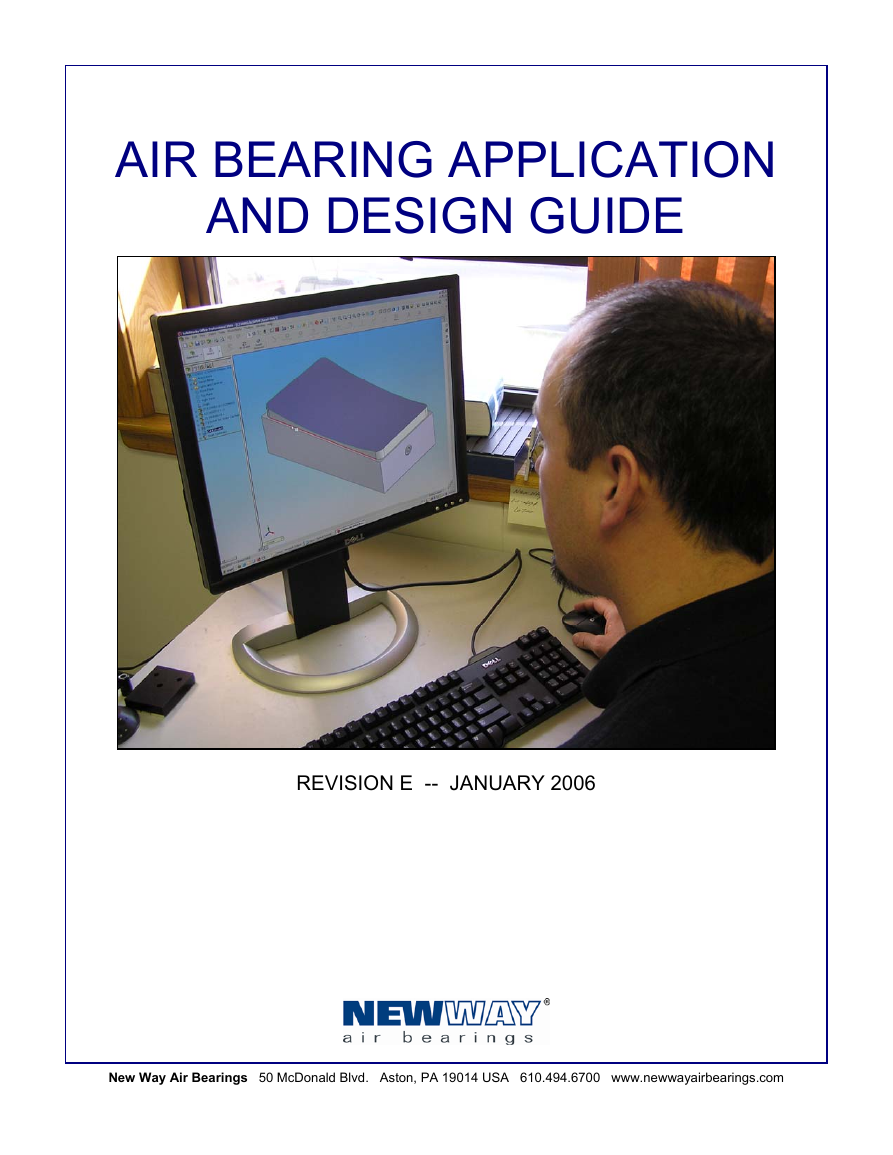
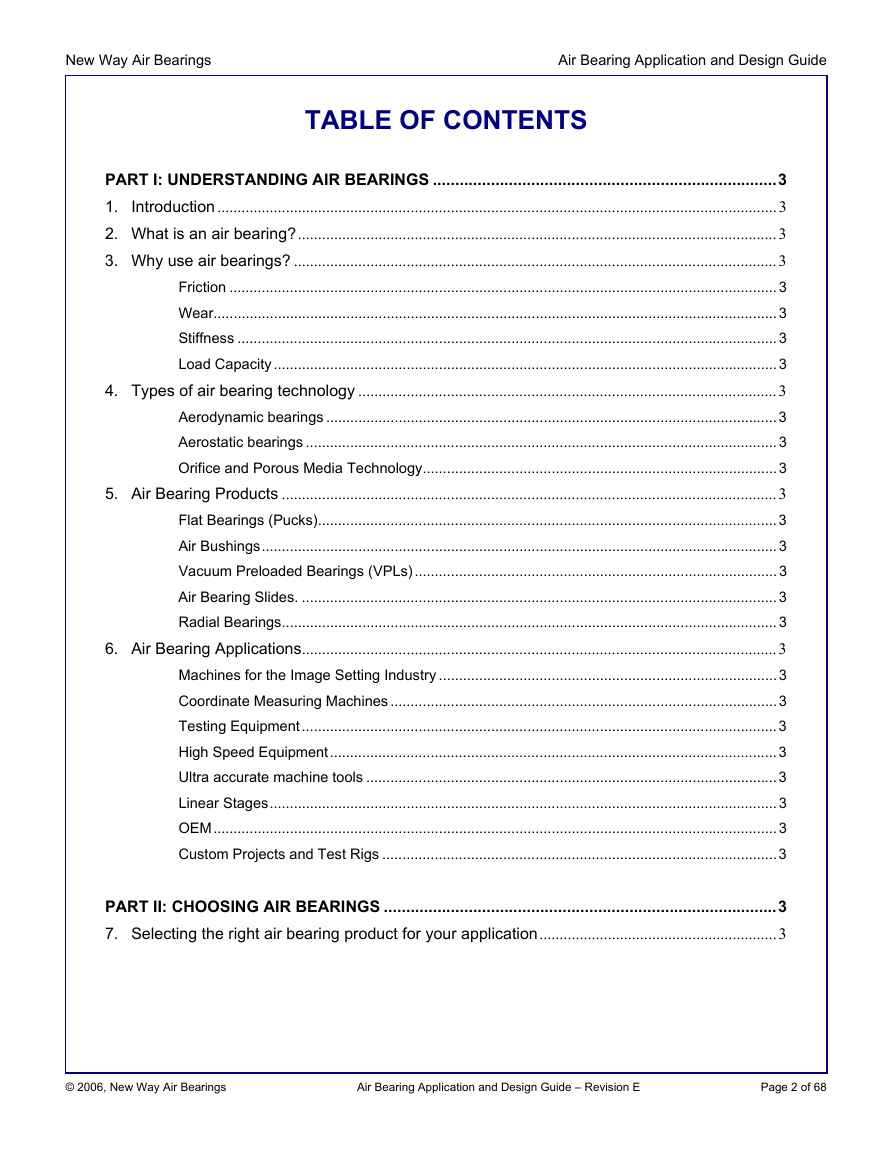
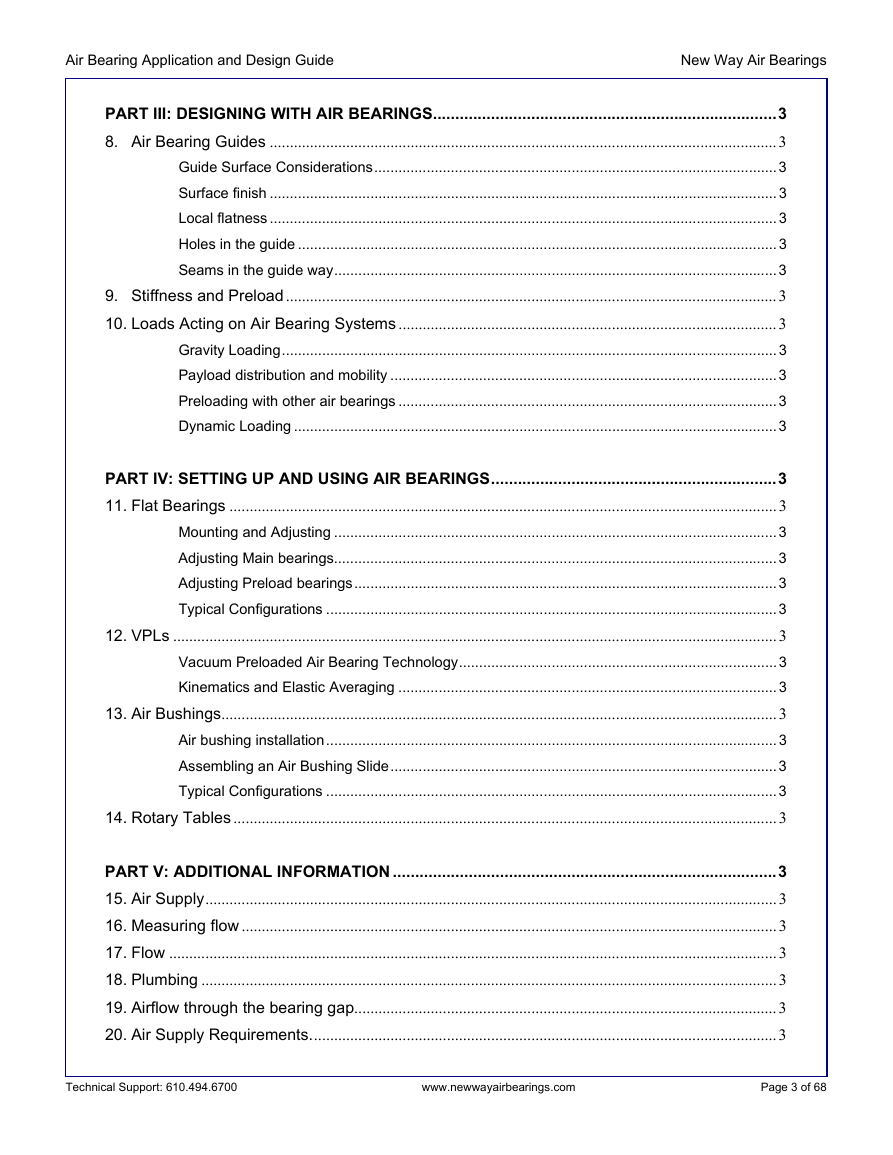
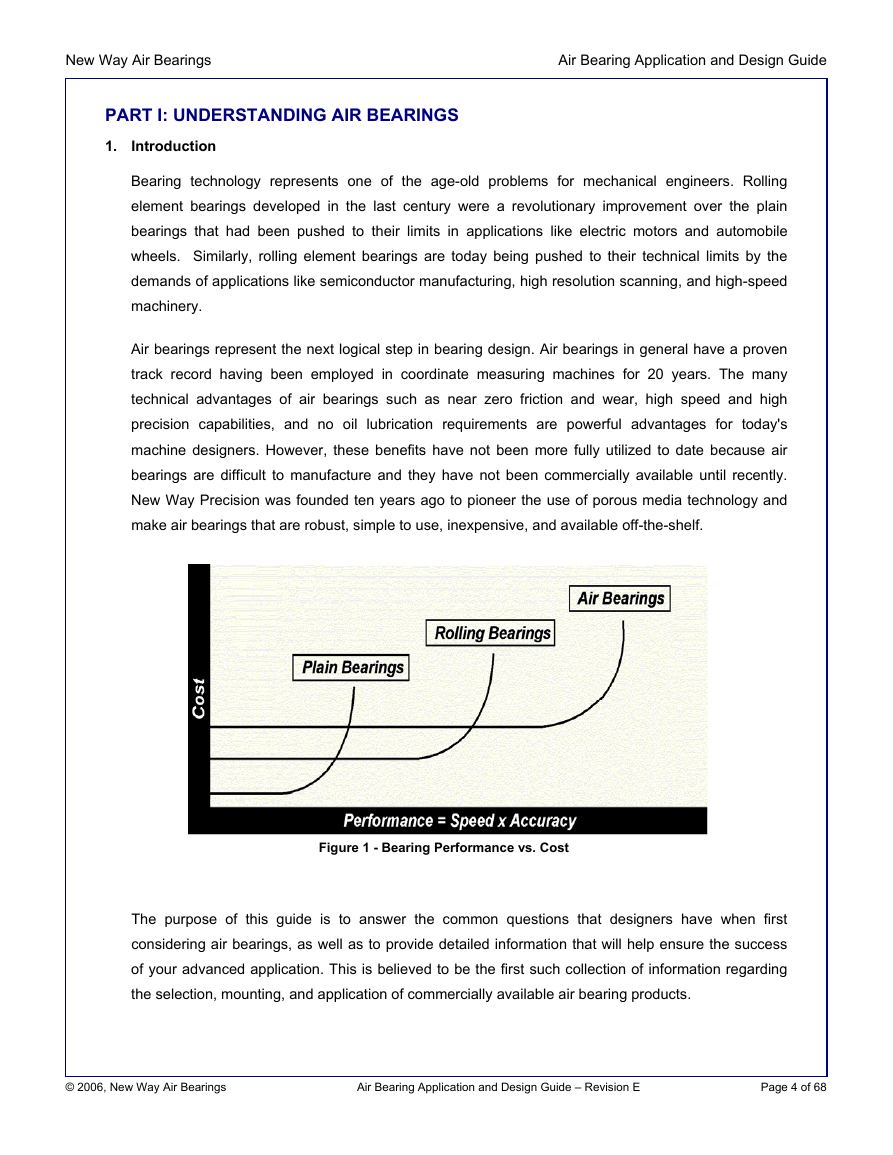

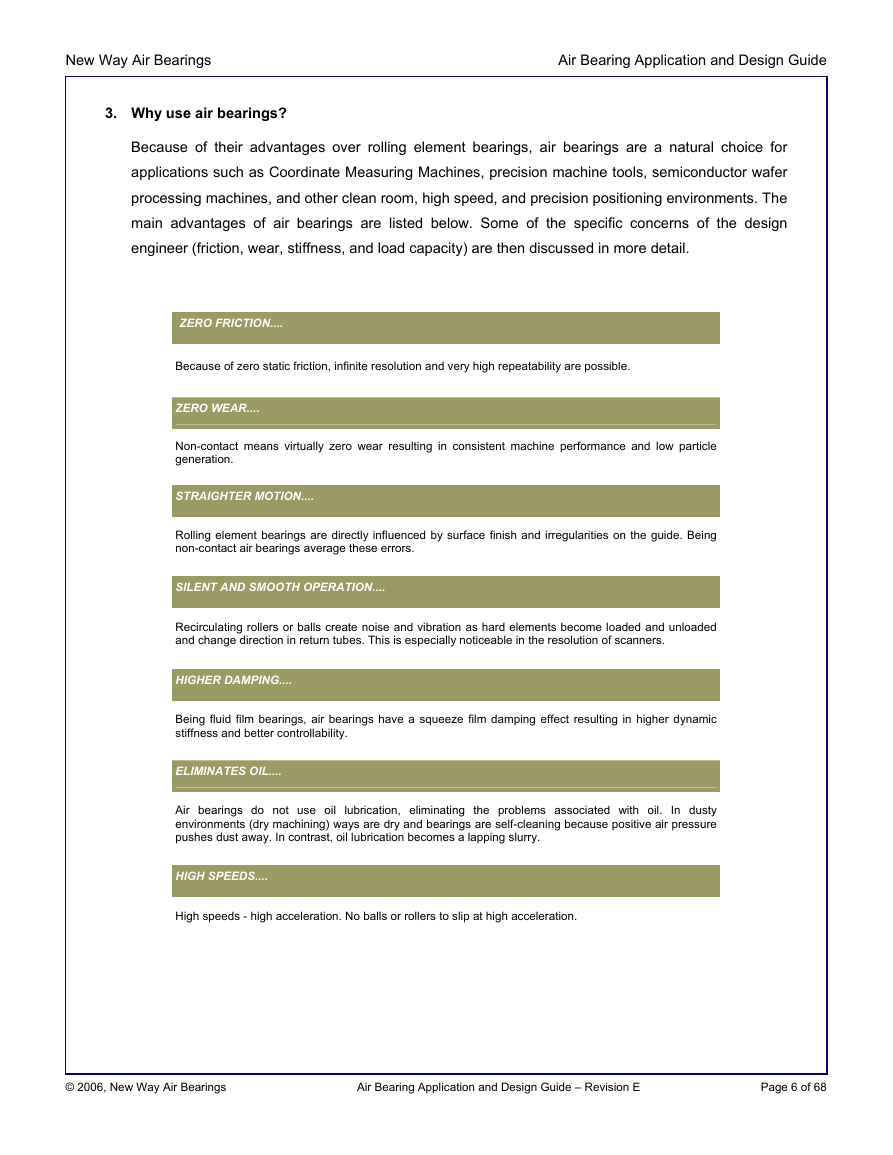

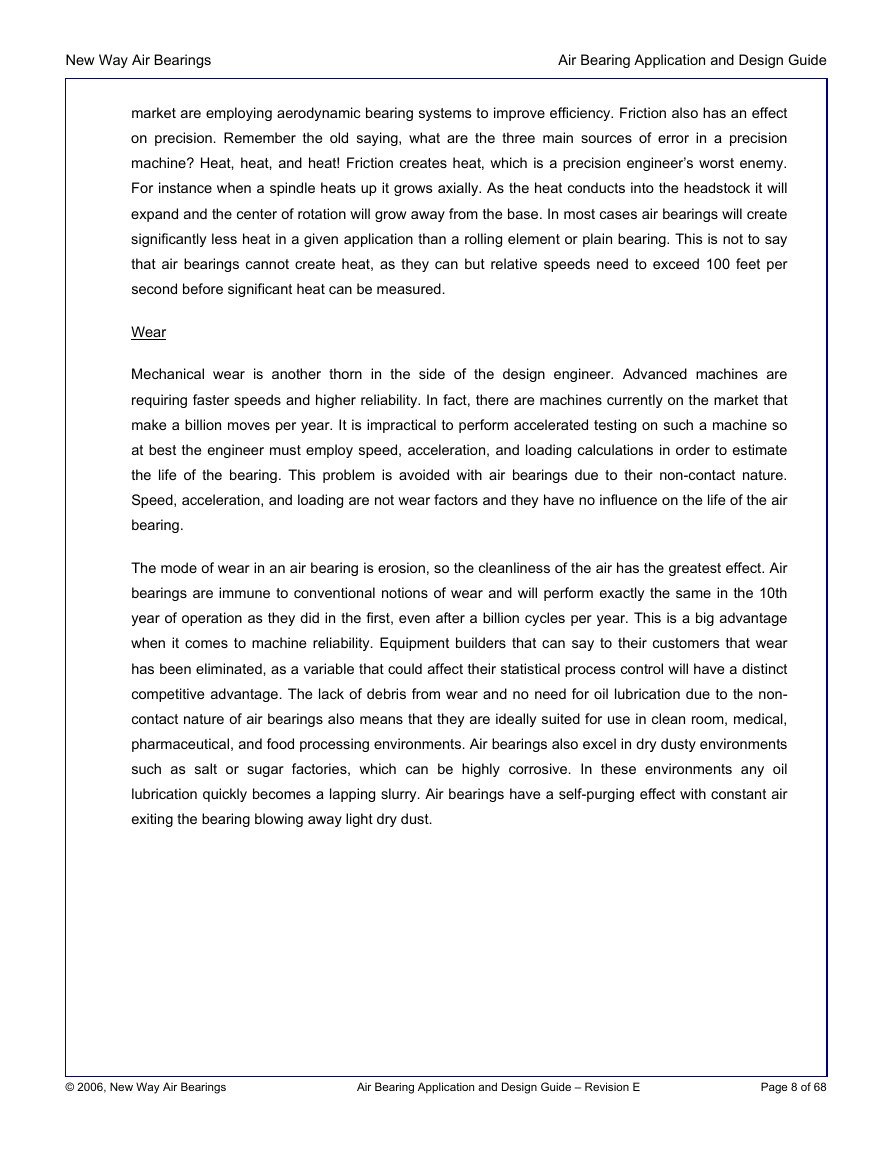








 2023年江西萍乡中考道德与法治真题及答案.doc
2023年江西萍乡中考道德与法治真题及答案.doc 2012年重庆南川中考生物真题及答案.doc
2012年重庆南川中考生物真题及答案.doc 2013年江西师范大学地理学综合及文艺理论基础考研真题.doc
2013年江西师范大学地理学综合及文艺理论基础考研真题.doc 2020年四川甘孜小升初语文真题及答案I卷.doc
2020年四川甘孜小升初语文真题及答案I卷.doc 2020年注册岩土工程师专业基础考试真题及答案.doc
2020年注册岩土工程师专业基础考试真题及答案.doc 2023-2024学年福建省厦门市九年级上学期数学月考试题及答案.doc
2023-2024学年福建省厦门市九年级上学期数学月考试题及答案.doc 2021-2022学年辽宁省沈阳市大东区九年级上学期语文期末试题及答案.doc
2021-2022学年辽宁省沈阳市大东区九年级上学期语文期末试题及答案.doc 2022-2023学年北京东城区初三第一学期物理期末试卷及答案.doc
2022-2023学年北京东城区初三第一学期物理期末试卷及答案.doc 2018上半年江西教师资格初中地理学科知识与教学能力真题及答案.doc
2018上半年江西教师资格初中地理学科知识与教学能力真题及答案.doc 2012年河北国家公务员申论考试真题及答案-省级.doc
2012年河北国家公务员申论考试真题及答案-省级.doc 2020-2021学年江苏省扬州市江都区邵樊片九年级上学期数学第一次质量检测试题及答案.doc
2020-2021学年江苏省扬州市江都区邵樊片九年级上学期数学第一次质量检测试题及答案.doc 2022下半年黑龙江教师资格证中学综合素质真题及答案.doc
2022下半年黑龙江教师资格证中学综合素质真题及答案.doc